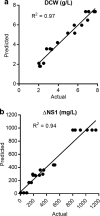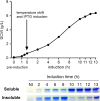Optimization and scale-up production of Zika virus ΔNS1 in Escherichia coli: application of Response Surface Methodology
- PMID: 31893321
- PMCID: PMC6938527
- DOI: 10.1186/s13568-019-0926-y
Optimization and scale-up production of Zika virus ΔNS1 in Escherichia coli: application of Response Surface Methodology
Abstract
Diagnosing Zika virus (ZIKV) infections has been challenging due to the cross-reactivity of induced antibodies with other flavivirus. The concomitant occurrence of ZIKV and Dengue virus (DENV) in endemic regions requires diagnostic tools with the ability to distinguish these two viral infections. Recent studies demonstrated that immunoassays using the C-terminal fragment of ZIKV NS1 antigen (ΔNS1) can be used to discriminate ZIKV from DENV infections. In order to be used in serological tests, the expression/solubility of ΔNS1 and growth of recombinant E. coli strain were optimized by Response Surface Methodology. Temperature, time and IPTG concentration were evaluated. According to the model, the best condition determined in small scale cultures was 21 °C for 20 h with 0.7 mM of IPTG, which predicted 7.5 g/L of biomass and 962 mg/L of ΔNS1. These conditions were validated and used in a 6-L batch in the bioreactor, which produced 6.4 g/L of biomass and 500 mg/L of ΔNS1 in 12 h of induction. The serological ELISA test performed with purified ΔNS1 showed low cross-reactivity with antibodies from DENV-infected human subjects. Denaturation of ΔNS1 decreased the detection of anti-ZIKV antibodies, thus indicating the contribution of conformational epitopes and confirming the importance of properly folded ΔNS1 for the specificity of the serological analyses. Obtaining high yields of soluble ΔNS1 supports the viability of an effective serologic diagnostic test capable of differentiating ZIKV from other flavivirus infections.
Keywords: E. coli; Heterologous protein production; Response Surface Methodology; Serological diagnosis; Soluble expression; Zika NS1.
Conflict of interest statement
The authors have a patent application on the gene sequence of the Zika virus used for differential diagnosis (Number: BR 10 2016011318 0) and another patent on the ΔNS1 production process developed (Number: BR 10 2018067345 9).
Figures




Similar articles
-
Multi-epitope Antigen for Specific Serological Detection of Dengue Viruses.Viruses. 2023 Sep 16;15(9):1936. doi: 10.3390/v15091936. Viruses. 2023. PMID: 37766342 Free PMC article.
-
Validation of serological and molecular methods for diagnosis of zika virus infections.J Virol Methods. 2019 Jan;263:68-74. doi: 10.1016/j.jviromet.2018.10.011. Epub 2018 Oct 18. J Virol Methods. 2019. PMID: 30342068
-
Serological tests reveal significant cross-reactive human antibody responses to Zika and Dengue viruses in the Mexican population.Acta Trop. 2020 Jan;201:105201. doi: 10.1016/j.actatropica.2019.105201. Epub 2019 Sep 25. Acta Trop. 2020. PMID: 31562846
-
Zika virus structural biology and progress in vaccine development.Biotechnol Adv. 2018 Jan-Feb;36(1):47-53. doi: 10.1016/j.biotechadv.2017.09.004. Epub 2017 Sep 12. Biotechnol Adv. 2018. PMID: 28916391 Review.
-
Modulation of Dengue/Zika Virus Pathogenicity by Antibody-Dependent Enhancement and Strategies to Protect Against Enhancement in Zika Virus Infection.Front Immunol. 2018 Apr 23;9:597. doi: 10.3389/fimmu.2018.00597. eCollection 2018. Front Immunol. 2018. PMID: 29740424 Free PMC article. Review.
Cited by
-
Enhanced production of a recombinant xylanase (XT6): optimization of production and purification, and scaled-up batch fermentation in a stirred tank bioreactor.Sci Rep. 2023 Nov 28;13(1):20895. doi: 10.1038/s41598-023-48202-5. Sci Rep. 2023. PMID: 38017111 Free PMC article.
-
Seroprevalence of Zika in Brazil stratified by age and geographic distribution.Epidemiol Infect. 2023 Nov 15;151:1-16. doi: 10.1017/S0950268823001814. Online ahead of print. Epidemiol Infect. 2023. PMID: 37965751 Free PMC article.
-
Validation of Serological Methods for COVID-19 and Retrospective Screening of Health Employees and Visitors to the São Paulo University Hospital, Brazil.Front Cell Infect Microbiol. 2022 Jun 2;12:787411. doi: 10.3389/fcimb.2022.787411. eCollection 2022. Front Cell Infect Microbiol. 2022. PMID: 35719329 Free PMC article.
-
Anti-Flavivirus Vaccines: Review of the Present Situation and Perspectives of Subunit Vaccines Produced in Escherichia coli.Vaccines (Basel). 2020 Aug 31;8(3):492. doi: 10.3390/vaccines8030492. Vaccines (Basel). 2020. PMID: 32878023 Free PMC article. Review.
-
Multi-epitope Antigen for Specific Serological Detection of Dengue Viruses.Viruses. 2023 Sep 16;15(9):1936. doi: 10.3390/v15091936. Viruses. 2023. PMID: 37766342 Free PMC article.
References
-
- Abergel C, Coutard B, Byrne D, Chenivesse S, Claude JB, Deregnaucourt C, Fricaux T, Gianesini-Boutreux C, Jeudy S, Lebrun R, Maza C, Notredame C, Poirot O, Suhre K, Varagnol M, Claverie JM. Structural genomics of highly conserved microbial genes of unknown function in search of new antibacterial targets. J Struct Funct Genomics. 2003;4(2–3):141–157. doi: 10.1023/A:1026177202925. - DOI - PubMed
-
- Amorim JH, Porchia BF, Balan A, Cavalcante RC, da Costa SM, de Barcelos Alves AM, de Souza Ferreira LC. Refolded dengue virus type 2 NS1 protein expressed in Escherichia coli preserves structural and immunological properties of the native protein. J Virol Methods. 2010;167(2):186–192. doi: 10.1016/j.jviromet.2010.04.003. - DOI - PubMed
-
- Balmaseda A, Stettler K, Medialdea-Carrera R, Collado D, Jin X, Zambrana JV, Jaconi S, Cameroni E, Saborio S, Rovida F, Percivalle E, Ijaz S, Dicks S, Ushiro-Lumb I, Barzon L, Siqueira P, Brown DWG, Baldanti F, Tedder R, Zambon M, de Filippis AMB, Harris E, Corti D. Antibody-based assay discriminates Zika virus infection from other flaviviruses. Proc Natl Acad Sci. 2017;114(31):8384–8389. doi: 10.1073/pnas.1704984114. - DOI - PMC - PubMed
Grants and funding
LinkOut - more resources
Full Text Sources

